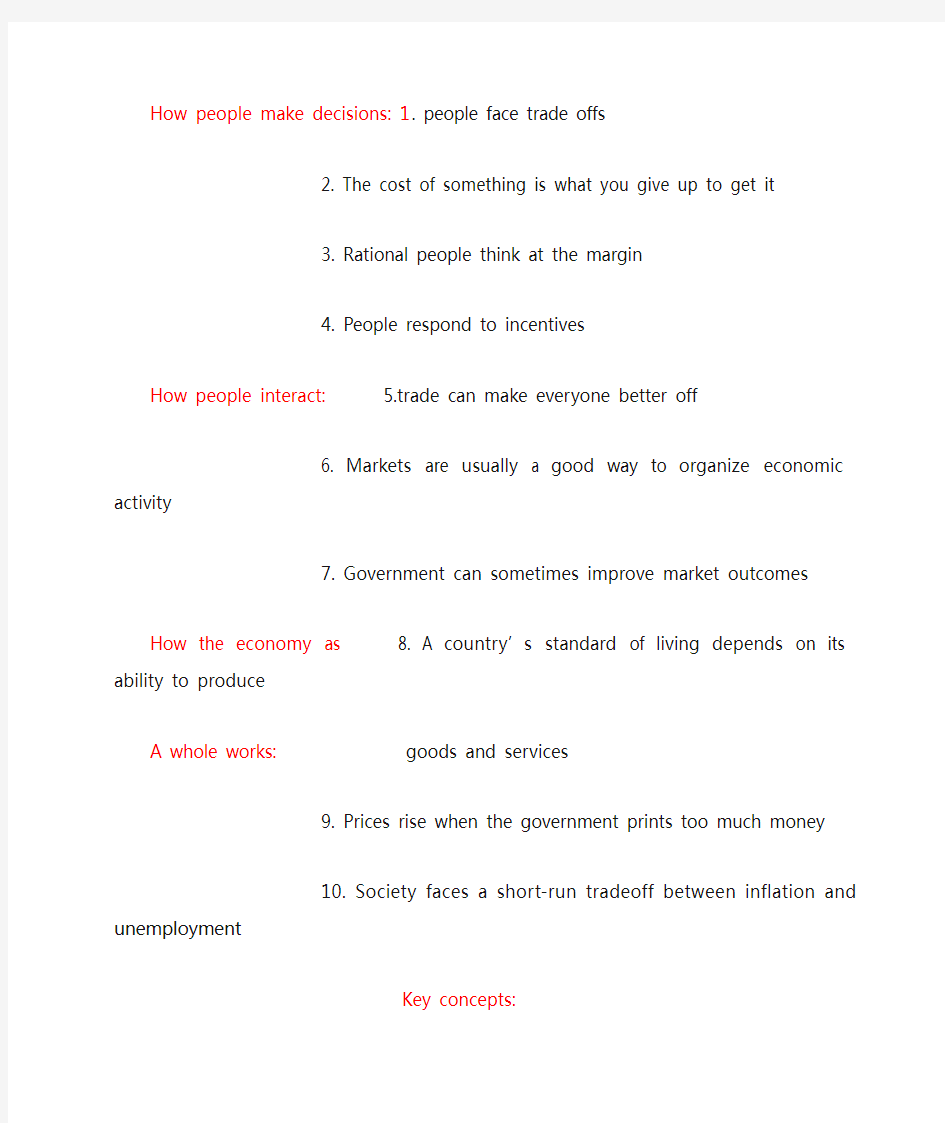经济学名词解释_英文版

- 1、下载文档前请自行甄别文档内容的完整性,平台不提供额外的编辑、内容补充、找答案等附加服务。
- 2、"仅部分预览"的文档,不可在线预览部分如存在完整性等问题,可反馈申请退款(可完整预览的文档不适用该条件!)。
- 3、如文档侵犯您的权益,请联系客服反馈,我们会尽快为您处理(人工客服工作时间:9:00-18:30)。
How people make decisions: 1. people face trade offs
2. The cost of something is what you give up to get it
3. Rational people think at the margin
4. People respond to incentives
How people interact: 5.trade can make everyone better off
6. Markets are usually a good way to organize economic activity
7. Government can sometimes improve market outcomes
How the economy as 8. A country’s standard of living depends on its ability to produce
A whole works: goods and services
9. Prices rise when the government prints too much money
10. Society faces a short-run tradeoff between
inflation and unemployment
Key concepts:
Ability-to-pay principle(税收的)能力支付原则: The idea that taxes should be levied on a person according to how well that person can shoulder the burden
Absolute advantage绝对优势: The comparison among producers of a good according to their productivity
Accounting profit会计利润: Total revenue minus total explicit cost Adverse selection逆向选择: The tendency for the mix of unobserved attributes to become undesirable from the standpoint of an uninformed party Agent代理人: A person who is performing an act for another person, called the principal
Aggregate-demand curve: a curve that shows the quantity of goods and services that households, firms, and the government want to buy at each price level
Aggregate risk: risk that affects all economic actors at once
Aggregate-supply curve: a curve that shows the quantity of goods and services that firms choose to produce and sell at each price level Appreciation: an increase in the value of a currency as measured by the amount of foreign currency it can buy
Arrow’s impossibility theorem阿罗不可能定理: A mathematical result showing that, under certain assumed conditions, there is no scheme for aggregating individual preferences into a valid set of social preferences
Average fixed cost平均固定成本: Fixed costs divided by the quantity of output
Average revenue平均收益: Total revenue divided by the quantity sold Average tax rate平均税率: Total taxes paid divided by total income Average total cost平均总成本: Total cost divided by the quantity of output Average variable cost平均可变成本: Variable costs divided by the quantity of output
Automatic stabilizers: changes in fiscal policy that stimulate aggregate demand when the economy goes into a recession without policymakers having to take any deliberate action
Balance trade: a situation in which exports equal imports
Benefits principle受益原则: The idea that people should pay taxes based on the benefits they receive from government services
Bond: a certificate of indebtedness
Budget constraint预算约束: The limit on the consumption bundles that a consumer can afford
Budget deficit预算赤字: An excess of government spending over government receipts
Budget surplus预算盈余: An excess of government receipts over government spending
Business cycle经济周期: Fluctuations in economic activity, such as employment and production
Capital资产: The equipment and structures used to produce goods and services
Capital flight: a large and sudden reduction in the demand for assets located in a country
Cartel 卡特尔: A group of firms acting in unison
Catch-up effect 后发效应: the property whereby countries that start off poor tend to grow more rapidly that countries that start off rich
Central bank: an institution designed to oversee the banking system and regulate the quantity of money in the economy
Circular-flow diagram循环流向图: A visual model of the economy that shows how dollars flow through markets among households and firms Closed economy: an economy that does not interact with other economies in the world
Collective bargaining: the process by which unions and firms agree on the terms of employment
Commodity money: money that takes the form of a commodity with intrinsic value
